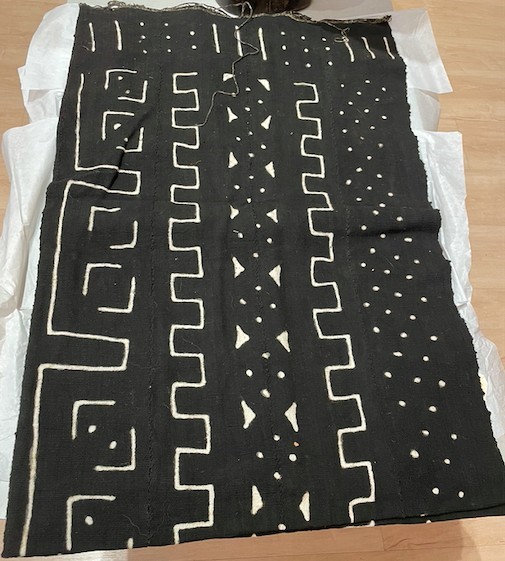Object ID: 2009.002.24
Object Name: Textile
Artist/Maker: Unrecorded Bamana artist Culture: Bamana People, Mali
Title: Bamana “Mudcloth”
Medium: Woven textiles and resist-dye Dimension Details: H-67 W-45 inches
On Campus Collection: UWM Art Collection Gift of Mark and Mary Jo Wentzel
One of the most widely celebrated African textile forms is the bogolanfini which is created by the Bamana peoples of Mali. The term means mud-dyed cloth and comes from Bambara, the language of the Bamana. The origins of the art form date back to the twelfth century, and the style has been experiencing a resurgence in popularity since the 1970s. Today, bogolanfini textiles function as a symbol of pride in the Bamana/African identity. Object 2009.002.24 from the UWM Mathis Gallery is a traditional bogolanfini. Its artist and date of creation are unknown, but it was likely produced between the 19th and 20th centuries.
In the creation of bogolanfini, men would weave strips of cotton cloth and sew them together1. The decoration of the canvas was completed by women, who would first immerse the cloth in a bath of leaf dyes to initiate the resist process. After drying, women would hand-paint the dark areas of the cloth’s pattern with fermented mud from the Niger River. Once the mud is removed, the dark color is retained because of a reaction between the mud and the leaf extracts.
Bleach is then applied to the areas of negative space, which turn white after drying in the sun for a week.2 The decorative motifs on the cloth are typically abstract patterns and representations of everyday objects. A combination of motifs can express “a proverb or a song, articulate a message, or represent an historical event.”3 The textiles are worn by both men and women, initially by performers or hunters. They are also worn during transitional periods of a person’s life.4 For example, a woman might wear a bogolanfini following childbirth or preceding a marriage.5
In the past, young women would learn how to decorate the textiles from their mothers in a long-term apprenticeship. However, the popularity of European fabrics in the 1960s threatened the continued creation of bogolanfini. Fewer young women desired to learn the technique, which prompted young men to learn in their stead.6 The resurgence of the textile’s popularity occurred in 1970 and initiated a new generation of mud-cloth creators. The original patterns were still produced, but variations of the designs were newly experimented with in modern clothing and the decorative arts. Today, there is a distinction between traditional bogolanfini and their inspired objects, referred to simply as bogolan.7 Since 1970, both forms have been celebrated as indications of national and cultural pride.
As a bogolanfini, Object 2009.002.24 belongs to one of the most popular West African textile forms. Many mud-cloths retain a yellow tinge from the leaf dyeing process, but this textile serves as an excellent example of the characteristic white-on-black color contrast. It is listed on the collection’s website as a ceremonial artifact, suggesting that it may have been worn in Bamana performances. A few of the patterns on this object are identifiable as traditional symbols. The three parallel lines are abstract representations of a spindle for weaving cloth, which symbolizes wealth and luxury. This is one of the oldest bogolanfini designs. Also, the diamond formation made up of four dots and separated by triangles may be a variation of a similar pattern that references a belt worn by warriors. This symbol signifies that the wearer is brave. Though the precise meaning of this textile’s symbols has not been ascertained, its design refers to traditional Bamana social practices and contributes to its function as a distinctive marker of the Bamana/African identity.8
1 “Wrapper (Bogolanfini),” The Metropolitan Museum of Art, accessed November 8, 2022, https://www.metmuseum.org/art/collection/search/312395.
2 Victoria Rovine, “Bogolanfini in Bamako: The Biography of a Malian Textile,” African Arts 30, vol. 1 (Winter 1997): 41. https://www-jstor-org.ezproxy.lib.uwm.edu/stable/3337471.
3 “Wrapper (Bogolanfini),” The Metropolitan Museum of Art.
4 Jean-Paul Colleyn, ed., Bamana: The Art of Existence in Mali (New York: Museum for African Art, 2001), 51.
5 “Wrapper (Bogolanfini),” The Metropolitan Museum of Art.
6 Rovine, “Bogolanfini in Bamako,” 41.
7 Rovine, “Bogolanfini in Bamako,” 41.
8 Colleyn, Bamana: The Art of Existence in Mali, 51.
Bibliography
Colleyn, Jean-Paul, ed. Bamana: The Art of Existence in Mali. New York: Museum for African Art, 2001.
Rovine, Victoria. “Bogolanfini in Bamako: The Biography of a Malian Textile.” African Arts 30, no. 1 (Winter 1997): 40-51, 94-96. https://www-jstor-org.ezproxy.lib.uwm.edu/stable/
3337471.
“Wrapper (Bogolanfini).” The Metropolitan Museum of Art. Accessed November 8, 2022. https://www.metmuseum.org/art/collection/search/312395.
